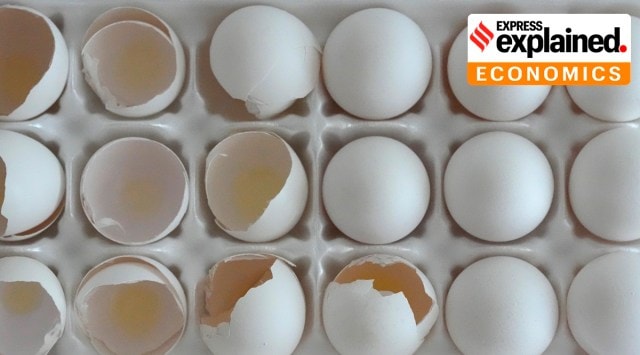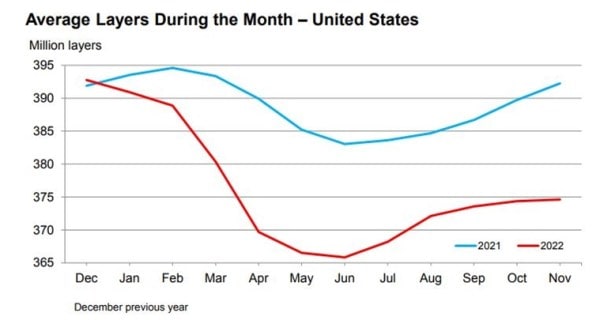While inflation has eased, why are eggs still so expensive in the US?
The rise in egg prices was a bane for consumers across the US, especially during the holiday season. Here is what led to it.
 The lingering bird flu outbreak, combined with soaring feed, fuel and labor costs, drove egg prices up significantly. (Photo: AP /Charles Rex Arbogast)
The lingering bird flu outbreak, combined with soaring feed, fuel and labor costs, drove egg prices up significantly. (Photo: AP /Charles Rex Arbogast) Hens might not be known as high-fliers, but egg prices are currently soaring in the US. In a year where Americans saw their grocery store bills balloon overall, the price of eggs witnessed a particularly steep rise.
Average egg prices jumped 49.1 per cent in November 2022 compared to a year earlier — the largest annual percentage increase among all grocery items in that period, according to the consumer price index, reported CNBC. The price rise was even higher for Grade A eggs in the above period – from $ 1.72 to $ 3.59 (more than double) for a dozen according to government sources, reported AP.
For perspective, overall “food inflation” according to the US Bureau of Labour Statistics as of December 2022, stood at 10.4 per cent.
The rise in egg prices was a bane for consumers across the country, especially during the holiday season, with popular recipes using eggs as a key basic ingredient.
The Indian Express explains the high price of eggs in the US.
Avian flu affecting supplies
A major driver behind soaring egg prices in the US over the past year has been the country’s tryst with various outbreaks of deadly avian flu. According to a Centers for Disease Control and Prevention report updated on January 11, nearly 58 million birds were estimated to have been affected by the Highly pathogenic avian influenza (HPAI) A(H5) viruses beginning January 2022, with 729 reported outbreaks. The year 2022 saw the deadliest outbreak of avian flu in US history.
The reason why avian flu has had such a huge impact is because it is both lethal (killing 90-100 per cent of affected birds) as well as highly contagious. According to US federal rules, once the flu is detected in a farm, farmers must kill their remaining stocks to prevent further spread.
 Source: US Department of Agriculture
Source: US Department of Agriculture
Out of the nearly 58 million egg-laying hens, poultry chickens and turkeys that died due to avian flu or in the subsequent cullings, more than 43 million were egg-laying hens, reported AP. This has had a massive impact on egg-production in the country. According to US Department of Agriculture data from December 20, 2022, egg production was down to 8.87 billion eggs in November 2022 from over 9.3 billion eggs a year ago – a nearly 5 per cent decrease.
Clashing with peak demand
While this might not seem catastrophic, the timing of 2022’s flu outbreaks has been especially crippling. Surprisingly reemerging in September 2022 – it typically hits during the spring and disappears by summer – the autumn outbreaks coincided with rising festive demand.
In the US, the festive time ushers in significantly higher consumption of eggs. Since eggs are used in all kinds of baking recipes as well as a cheap source of protein in the winter months, a disruption in supply at this crucial time of the year was doubly deleterious.
Stories of restaurants and bakeries massively hiking prices to meet rising egg costs during the holiday season have been rampant.
Rising costs of inputs
Not only did 2022 see historic outbreaks of avian flu, it also saw rampant inflation in general. This too had contributed to rising egg prices as the cost of inputs increased. For some experts, it was rising input costs rather than bird flu which were the main drivers behind skyrocketing egg prices.
“When you’re looking at fuel costs go up, and you’re looking at feed costs go up as much as 60%, labor costs, packaging costs — all of that … those are much much bigger factors than bird flu for sure,” Emily Metz, president and CEO of the American Egg Board trade group, told AP.
Supply chain snarls, inflated costs of factory goods due to parts shortages and rising global oil prices on the back of the Ukraine-Russia conflict, have all contributed to 6.5 per cent overall inflation in 2022, US Bureau of Labor Statistics data showed. Outbreaks of avian flu in this inflationary climate only added to steep rises that would have been seen anyway.
In some states, like California, egg prices are as high as $7 for a dozen, mainly attributed to a state law which requires egg producers to raise cage-free hens, that went into effect last year, reported Forbes. While considered more humane than traditionally caged egg-laying hens, this increases farmers’ costs as more land is required to house the same number of hens.
Increasing demand for eggs
Despite soaring prices, eggs have continued to show a steady rise in demand. Consumption has risen 17 per cent between 2012 and 2021, according to a report from the USDA, and has even outpaced red meats. One possible factor behind this is increasing focus on personal health and diets. Considered a healthier protein alternative to red meats, eggs have dominated the diets of those seeking to build muscle mass.
Notably, despite their rising prices, eggs are still considered cheap sources of protein. A pound of chicken breasts went for $ 4.42 on average in November and a pound of ground beef sold for $4.85, according to the US Bureau of Labor Statistics. This has meant that despite the disproportionate price rise, the demand for eggs has not really been affected. This only further adds to soaring egg prices.
Respite soon?
Jada Thomson, a University of Arkansas agricultural economist, told AP there may be some relief coming in egg prices in the next couple months because egg farmers have been steadily replacing their flocks lost to bird flu last year and demand will ease a bit now that people are done with their holiday baking.
Overall, inflation in the US has significantly eased over the last month of 2022 and early 2023 – possibly heralding easing egg prices in the future. However, currently, as supplies are still not at the pre-avian flu levels, eggs remain a costly purchase in the US.
- 01
- 02
- 03
- 04
- 05






































